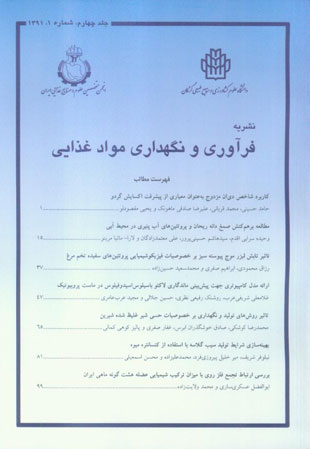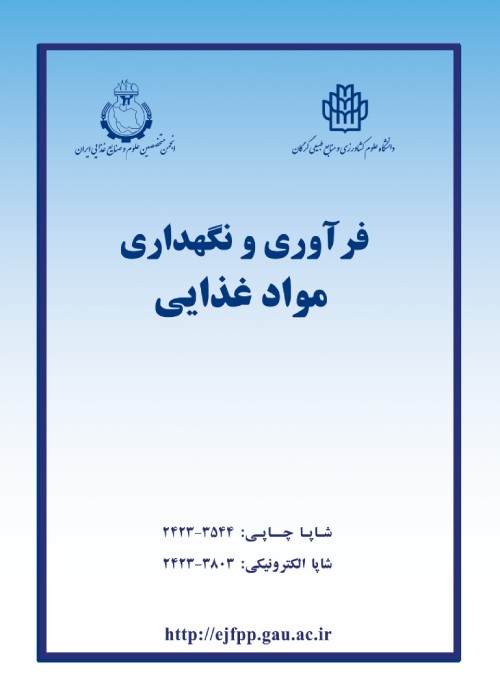فهرست مطالب

نشریه فرآوری و نگهداری مواد غذایی
سال چهارم شماره 1 (پیاپی 11، بهار و تابستان 1391)
- تاریخ انتشار: 1392/09/01
- تعداد عناوین: 7
-
صفحات 37-46مقدمهکاربرد تابش های نوری مختلف بویژه طول موج کوتاه و لیزر در صنعت غذا به جهت غیر فعال سازی شمار زیادی از میکروارگانیسم پاتوژن غذا زاد عامل ایجاد بیماری و مسمومیت به عنوان یک تکنولوژی مناسب و جدید مطرح می باشد.مواد و روش هاتاثیر تابش لیزر موج پیوسته سبز بر ویژگی های ساختاری (با استفاده از-PAGE SDS) و فیزیکوشیمیایی (ارزیابی خصوصیات ارگانولپتیکی و pH) پروتئین های سفیده تخم مرغ مورد مطالعه قرار گرفت.یافته هاارزیابی های الکترفورز نمونه های سفیده تخم مرغ نشان داد که تیمارهای لیزر موج پیوسته سبز در این مطالعه فاقد تاثیری بر خصوصیات ساختاری و باندهای پروتئینی سفیده تخم مرغ بوده و همچنین اثرات نامطلوبی در خصوصیات ارگانولپتیکی (رنگ و بو) سفیده تخم مرغ ایجاد ننمود. نمونه کنترل و نمونه های تیمار شده هیچ گونه تفاوت آماری معنی داری را در مقادیر pH شان نشان ندادند.بحث و نتیجه گیریبهره گیری از روش تابش لیزر موج پیوسته سبز در عرصه سالم سازی تخم مرغ های شکسته در صنعت غذا می تواند مورد توجه قرار گیرد.
کلیدواژگان: لیزر، الکتروفورز، تخممرغ، پروتئین -
صفحات 81-97با به کارگیری طرح ترکیبی(combined design) تاثیر نسبت های مختلف محلول ساکارز به کنسانتره میوه(پرتقال و آلبالو)، میزان کلریدکلسیم(0-2درصد) و مدت زمان نگهداری(0-90 روز) بر ویژگی های فیزیکوشیمیایی سیب های گلاسه مورد مطالعه قرار گرفت. شاخص هایی از قبیل میزان قند کل، اسید آسکوربیک، رنگ و پذیرش کلی محصول بر مبنای فاکتورهای مورد مطالعه مدلسازی و سپس بهینه سازی چند منظوره(multiobjective optimization) با به کارگیری روش های عددی(numerical method) انجام پذیرفت. بهینه سازی بر پایه بیشترین مدت زمان نگهداری محصول(در دمای 2 درجه سانتیگراد)، میزان اسید آسکوربیک، شاخص کروما و امتیاز حسی و کمترین میزان رطوبت سیب های گلاسه انجام گرفت. نقطه بهینه در نمونه های فرآوری شده با کنسانتره آب پرتقال در نسبت شربت ساکارز به کنسانتره 1 به 3، میزان کلریدکلسیم 96/0درصد و مدت زمان نگهداری 82 روز به دست آمد. در این نقطه، میزان اسید آسکوربیک، رطوبت، شاخص کروما و امتیاز حسی محصول به ترتیب برابر با 89/27 میلی گرم در هر صد گرم، 43/12 درصد، 04/56 و 81/5 می باشد. هم چنین، نقطه بهینه برای نمونه های فرآوری شده با کنسانتره آب آلبالو در نسبت مساوی شربت ساکارز به کنسانتره(2: 2)، میزان کلریدکلسیم 2درصد و مدت زمان نگهداری 90 روز به دست آمد. در این نقطه، میزان اسید آسکوربیک، رطوبت، شاخص کروما و امتیاز حسی محصول به ترتیب برابر با 75/8 میلی گرم در هر صد گرم، 80/12 درصد، 32/39 و 75/8 می باشد.
کلیدواژگان: سیب گلاسه، آبگیری اسمزی، کنسانتره میوه، اسید آسکوربیک
-
Pages 1-13Lipids and oils are susceptible to oxidation. Analytical protocols are requiredfor measuring their oxidation progress. Spectrophotometric, iodometric, andcolorimetric methods may apply for measuring the early stages of lipid oxidation.In this study, walnut samples were selected and were kept shelled or unshelled at62, 72 and 82˚С to evaluate the relationship between peroxide value andconjugated diene value. A number of chemical and physical characteristics ofwalnut kernel oil were determined. Measuring walnut oil conjugated dienes wascarried out spectrophotometrically by reading UV absorption at 233 nm. Peroxidevalue was measured by conventional titration method. The results showed thatperoxide value, conjugated diene value and acidity (by oleic acid) of fresh walnutwere 0.3 meqO2/kg, 4.354 μmol/g and 0.064 %, respectively. First order linearequations were found to correlate peroxide and conjugated diene values inextracted oil from whole walnut and in walnut kernel, during storage at differenttemperatures (62, 72 and 82˚С), with a regression coefficient of 0.98 and 0.99. Ageneralized equation was used for expressing the relationship between peroxideand conjugated diene values in walnut, because there was no significant differencebetween the equations slopes and intercepts for three temperature conditions andtwo walnut forms.Keywords: Walnut, Oil oxidation, Peroxide value, Conjugated diene value
-
Pages 15-35Proteins and polysaccharides generally affect the stability, structure, rheological properties and sensory attributes of many food systems. In this research, the phase behavior and rheology of systems containing different concentrations of Basil seed gum (BSG) and whey protein isolate (WPI) were investigated. The mixtures were prepared by 0-0.3% (w/w) of BSG and 1-5% (w/w) of WPI. Phase behavior investigation of the mixtures showed that polysaccharide-rich phase is located at lower phase as a turbid layer. The results showed that the single-phase systems observe only at high concentrations of BSG. In mixed systems, gelation and phaseseparation occurred simultaneously so that phase sepatation rate decreased significantly with an increase in BSG concentration due to self-association of BSG polysaccharide chains. Flow behavior of the mixtures was determined and the apparent viscosity at shear rates of 50 and 100 s-1 was reported. Furthermore, frequency sweep test was conducted and the results were reported at frequency of 1 and 10 Hz. The data showed that incorporation of little amount of BSG to WPI aqueous dispersions changed the behaviour of systems from newtonian to shearthinning behavior. The best fitted models for flow behavior data for low and high BSG concentrations in the mixtures were Ostwald and Herschel-Bulkley, respectively. Oscillatory measurements showed a diminishing trend in phase angle and presence of weak gel in the mixtures by increasing BSG concentration. From a practical point of view, the results of this study could be applicable in creation of optimum texture and pharmaceutical industry.Keywords: Dispersion, Basil Seed Gum, Whey Protein Isolate, rheology, phase behavior
-
Pages 37-46Application of optical radiation such as laser and other short wavelength radiation for inactivation of many food-borne pathogen microorganisms in food industry (as major challenges in the food industry and so that many diseases are resulted from this food contamination) was known as a new technology. Effects of green Continuous Waves lasers on structural (using SDS-PAGE method) and physicochemical properties (organoleptic and pH value) of egg Albumen proteins was studied. The results of SDS-PAGE showed that none of the laser radiation treatments, had not changes in structural nor Organoleptic properties (including color and odor quality) of egg white proteins even at the highest time used, Evaluation of the pH values showed no significant difference between control and treated samples in this study. Using of the green continuous-wave laser irradiation method in the food industry can be considered as a new sanitation method for breaking eggs.Keywords: Laser, Electrophoresis, Egg, Protein1
-
Pages 47-64Over the last few years, the use of artificial neural networks (ANNs) has increased in many areas of food science and artificial neural network have been applied to many Quality Control problems. The aim of this study is to develop and optimize artificial neural network models for forecast of viability of probiotic bacteria in yogurt. In this study, A Levenberg-Marquardt algorithm trained feedforward artificial neural was used as a model. Several parameters such as titratable acidity, pH, syneresis, color and bacterial counts (Streptococcus thermophilus, L. delbrueckii ssp. bulgaricus Lactobacillus acidophilus and the viability of probiotic bacteria are considered. The efficiency of the developed model was assessed through a calculate the Mean Square Error (MSE) and value of R2. The transfer function of the neural network model is effective in performance. The two tangent sigmoid and linear transfer function model is used to optimize pre-processing andwere compared. According to the results, the tangent sigmoid stimulation with 10 neurons in the hidden layer Here, the highest coefficients of determination on days 1, 7 and 14 during storage were (0.997, 0.994, 0.993) and the mean square error (MSE) 0.00056, 0.00075 and 0.00084 respectively. The overall accuracy of most models suitable for predicting viability of probiotic bacteria on during storage. Therefore, the best structure of a neural network to predict survival was 34-10-3.Keywords: Probiotic, Yoghurt, Neural networks, Lactobacillus acidophilus2
-
Pages 65-79Production of sweetened condensed milk from fresh milk has been studied. Onthe base of addition of the sugar in preparation of sweetened condensed milk twomethods were applied. In the first method dry sugar was added during forewarningof the milk and concentrated on the evaporator. The second method was used 62.5% syrup at the end of evaporation process of the milk. Products were stored threemonths in 4, 25 and 37 °C to study the sensory evaluation of sweetened condensedmilks. The obtained results were analyzed with randomized complete blocks designand split plot design. The formulation and temperature and interactive of thesefactors on variables of texture, color and sweetness showed significant differences.Samples stored at 4 °C received the best score. The type of packaging material andhomogenization method played a role at keeping the samples quality. According toobtained results, packaging in tin had the highest quality.Keywords: Sweetened condensed milk, Production methods, Homogenization, Packaging, sensory evaluation
-
Pages 81-97Effect of different ratios of sucrose to fruit concentrate (orange and sour cherry), level of CaCl2 (0-2%) and storage time (0-90 days) on physicochemical properties of candied apples were investigated using of a combined design. Different quality indices such as total sugars content, ascorbic acid, color attribute (chroma) and overall acceptance were modeled and then multiobjective optimization were made using numerical method. Optimization was based on maximization of storage time (at 2°C), ascorbic acid content, chroma and overall acceptance and minimization of moisture content. The optimum condition of candying by orange concentrate was found to be the ratio of syrup to concentrate 1:3, CaCl2 concentration of 0.96% and storage time of 82 days. At this optimum point, ascorbic acid content, moisture, chroma and overall acceptance were 27.89 mg/g, 12.43%, 56.04 and 5.8, respectively. In addition, the optimum conditions for candied apples processed by sour cherry concentrate, were found in equal portionof syrup to concentrate (2:2), CaCl2 concentration of 2% and storage time of 90 days. At this point, ascorbic acid content, moisture, chroma and overall acceptance were 8.75 mg/g, 12.80%, 39.32 and 8.7, respectively.Keywords: Candied apple, Osmotic dehydration, fruit concentrate, Ascorbic acid2
-
Pages 99-113A comparative study were conducted on concentration of Zinc and Protein, Lipid, Ash and Moisture in eight fish species of Cyprinus carpio, Oncorhynchus mykiss, Aristichthys nobilis, Hypophthalmichthys molitrix, Ctenopharyngodon idella, Scomberomorus commerson, Scomberomorus guttatus and Otolithes ruber. Metals were extracted from the tissues using wet digestion method and concentration of the heavy metals were measured by atomic absorption spectrophotometer. Data were analyzed with SPSS17 software in terms of t-test which determine presence or nonpresence of the significant difference in confidence level of 95% (P=0.05). Data were normalized Smirnov-Kolmogorof test. The relationship between heavy metal concentrations found in fish muscle and the chemical composition of the Pearson correlation test was used. The results of this study showed concentration of Zn in the muscle of fishes was 7.73±0.45 mg/Kg/ww. Also content of protein, lipid, ash in the muscle of fishes were 19.67±0.78, 2.45±0.45, 1.49±0.23 g/100g and level of moisture was 78±1.89 %. Results showed accumulation of Zn in musle of fishes with levels of protein, lipid, ash and moisture significant difference between them (P<0.05).Keywords: Zinc, Chemical Compositions, Muscle, Fish, Iran2


